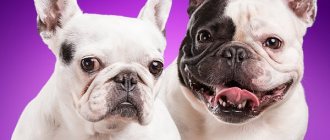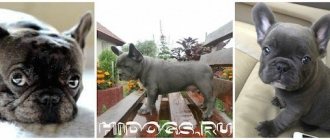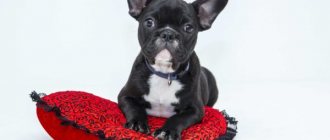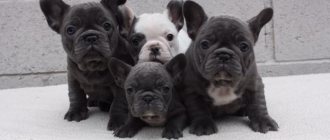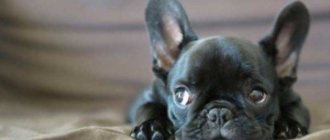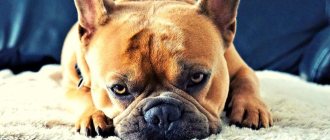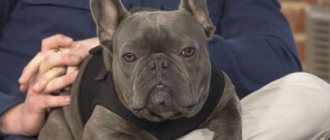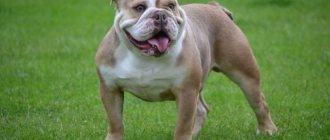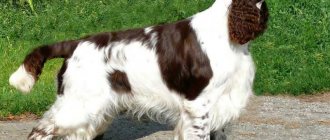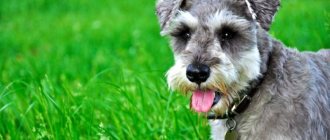Standard requirements for the French Bulldog breed. Standards for other canine systems. Vices and shortcomings.
The history of the breed began long before its recognition. French bulldogs are depicted in paintings by artists from various times. Their relatives are English bulldogs, pugs, and some types of small terriers.
Also in the ancestors there were mastiffs - large dogs with a tough temperament, which were kept for guarding, protection and fighting.
The 19th century brought glory to the breed. British workers brought French bulldogs to Paris. At first, dogs were not considered pets of the aristocracy; they lived among ordinary people.
At the end of the century, cynologists corrected the situation and introduced the French bulldog breed to the world. At the same time, the first standards, descriptions, and victories at exhibitions appeared.
Today, French bulldogs are favorites of thousands of families. They are bred in almost every corner of the world. They are ideal companions, active and inquisitive. They can be found at large and small exhibitions, and in courtyards while walking. They get along well with children, love adventure and are very dependent on their owner.
The French managed to breed loyal dogs with a bright appearance. Based on the history of standards, one can trace how the idea of small bulldogs has changed and what they have in common with their ancestors.
ICF standard (RKF)
This is one of the largest organizations in Eastern Europe. It has its own rules. The FCI (International Canine Federation) standard includes a description:
- Physique;
- Color;
- Type and structure of wool;
- Color of eyes, nose, claws, mucous membranes;
- Ears and tail;
- Movements;
- Character;
- Vices, shortcomings.
At the beginning of the standard there is a short story with important dates about the formation of the breed and its ancestors. The purpose of French bulldogs and the need for working tests are also indicated.
They were assigned to group 9 as indoor and decorative dogs. Next to them are pugs, Pekingese, Chihuahuas, Shih Tzus, poodles, and Maltese. Operational tests are not provided.
Important: The current version of the ICF standard was published on November 3, 2014. All changes in it are highlighted.
Appearance and color
French Bulldogs have clear boundaries. The weight of adult males is 9-14 kg, females – 8-13 kg. Height at the withers for the former is 27-35 cm, for the latter – 24-32 cm. A deviation in weight of 0.5 kg is allowed for both sexes. Also with height, dogs 1 cm higher or lower meet the requirements of the FCI document.
The modern French bulldog, despite its small stature, is a strong dog, with a compact build and muscular limbs. The tail is necessarily short from birth; docking of the tail, ears and dewclaws is not allowed.
It may have noticeable breaks. The tail is set low, even in a state of excitement it does not rise high due to the special structure of the body.
The breed must be compact. Large head with a rounded forehead and a small groove on the bridge of the nose. The ears are located at a distance from each other, but directed exclusively upward. Their tips are not sharp, but rounded. There are folds of skin around the bridge of the nose that form a soft cushion.
The eyes are large and round. Only dark brown. The nose is black, as are the claws. There is a snub nose. The neck is strong and wide, especially at the shoulders. The sacrum is slightly higher than the withers. This is facilitated by the hind limbs, which are longer than the front ones.
French Bulldogs have a barrel-shaped chest that drops below the elbows. The croup is noticeably sloping and the abdomen is slightly tucked. The movements are powerful and smooth.
Teeth must be complete, only overshot is allowed. The tongue is not visible when the jaw is closed.
Lifespan
Most French Bulldog dog owners are interested in the question of how long French Bulldogs live.
The first time flies by quite unnoticed in constant worries and worries about a dog with a small weight.
The owner gets used to his pet and thinks that he will live next to him in the house for many years.
As sad as it is to realize, statistics show that the life expectancy of a French bulldog is a maximum of 12 years.
A very small number of representatives of this breed go abroad for 10 years . It is extremely rare to meet a French bulldog over 15 years old.
The owner of a French bulldog does not need to be discouraged in advance; there is a chance that your pet could become the oldest bulldog on the planet and live up to 20 years.
It is scientifically proven that small dogs with low weight have a much longer life expectancy than large breeds.
Unfortunately, due to their innate characteristics, French bulldogs live several years less than many breeds of decorative dogs.
The weight of a newborn French bulldog puppy at the age of one month reaches 1.4 kg. At half a year the weight of males is 9-10 kg, and females - 8-9 kg.
After another 6 months, the weight of an adult French bulldog, according to the standard, should be 10-15 kg for males and 9-12 kg for females.
Acceptable colors
The standard considers the following options:
- Solid color;
- Spotted.
There are also two main colors - brindle fawn. Everyone has white spots, the size of which is practically unlimited. Their symmetrical arrangement is desirable in some color types.
The width of tiger stripes varies; sometimes the dog is so darkened that it appears completely black. Low-intensity speckling is allowed. Fawn French Bulldogs often have a black mask on their face. Color variations of this color come in light shades and bright red. The coat is short, without undercoat. Should fit tightly to the skin.
Important: Fawn color was added to the standard description only in 1995. Before this, it was considered prohibited in the breed, but such dogs were always born.
Limbs
FOREQUARTERS: General appearance: Set up vertically and straight when viewed from the side and front. Shoulders: obliquely set. Shoulder bones: massive, muscular, slightly curved. Elbows: located close to the body. Forearms: Short, straight and muscular Carpal joints (wrist): Short, not prominent. Pasterns: Short, slightly sloping in profile. Forelegs: round, compact, small, so-called “cat-like”, slightly turned outward. The fingers are tightly closed, the claws are short, thick, black.
HINDQUARTERS: General appearance: The hindquarters are strong and muscular, slightly longer than the forelimbs, which causes the sacrum to rise relative to the withers. Almost vertically set when viewed from both the side and rear. Hips: well-developed muscles, strong. Hocks: Set rather low, the hock angle is not too pronounced, but not straightened either. Tarsus: strong. Hocks: short. Hind feet: Round, compact, turned neither in nor out. MOVEMENT: The limbs move parallel to the longitudinal axis of the body, both when viewed from the front and from the side. Movements are free, powerful, smooth.
SKIN : Thick HAIR: Coat: short and smooth, close-lying, shiny and soft, without undercoat. Color: from light fawn to red, with or without brindle, with or without white spots. Solid Coat: Brindle: Light fawn to red coat with moderate dark brindles; with frequent brindling, the stripes should not completely cover the main color. A black mask is possible. Limited, small white markings are acceptable. Light Fawn to Red: Solid colors range from light fawn to red, with or without a black mask, but a black mask is preferred. Sometimes a lighter color is observed on the lower part of the body and limbs. There are small white markings. Coat with white spots: Brindle with moderate to significant amounts of white spots: Ideally, the white spots are distributed throughout the body. Light markings on the skin are acceptable. Color ranges from light fawn to red with moderate to significant amounts of white spots: Ideally, white spots are distributed throughout the body. Light markings on the skin are acceptable. The nose is always black in all colors, never brown or blue. A completely white color with a black eyelid rim and a black nose is acceptable, but such individuals are not used for breeding due to the risk of producing deaf offspring.
HEIGHT AND WEIGHT : Height at withers: males 27-35 cm, females 24-32 cm, deviations of 1 cm upward or downward from the indicated limits are allowed.
Weight : males from 9 kg to 14 kg; bitches from 8 kg to 13 kg. Exceeding the weight by 500 g is allowed provided that the breed type is maintained.
FAULTS: Any deviation from the above parameters should be considered a fault and assessed according to its severity and effect on the health and welfare of the dog.
- Intense speckling on the coat in brindle color with white spots;
- Intense speckling on the coat with a color ranging from light fawn to red with white spots;
- With a color ranging from light fawn to red, there is a wide black stripe along the spine;
- With any solid color - white markings on the paws;
- Light claws.
SERIOUS DISADVANTAGES:
- Exaggerated type, exaggerated breed characteristics;
- Muzzle is too long or too short;
- The tongue is visible when the mouth is closed;
- Light eyes (light eyes of a bird of prey).
- Horizontal top line from withers to loin;
- There is a more intense weakening of the pigment of the lips, nose, and rims of the eyelids, which should never be completely depigmented.
- Direct bite.
DISQUALIFYING FAULTS:
- Aggressive or cowardly behavior;
- Any dog with obvious physical or behavioral abnormalities must be disqualified;
- Lack of breed type, making the dog atypical for the breed;
- Completely closed nostrils;
- Jaw misalignment or lateral displacement of the jaw, which makes the tongue constantly visible;
- Dogs with the lower incisors located behind the upper incisors (scissor bite);
- Dogs whose fangs are constantly visible when their jaws are closed; discord;
- Nose any color except black;
- Erect ears;
- Lack of tail or ingrown tail;
- Dewclaws on the hind legs;
- Non-locking hock joints;
- Long, harsh, wiry or plump coat;
- Inappropriate coloration, namely black, black with tan markings (black and tan), and any dilution of the black color with or without white spots.
- Height and weight outside the limits specified in the standard;
- Dogs with difficulty breathing;
- Deafness.
Disadvantages and vices
They are given a lot of space in the standard. The main thing is that the appearance and other description of a particular French bulldog should be within its scope.
Defects affect color and pigmentation. Serious faults do not allow extreme types and traits, lightening, level bite, horizontal topline.
Disqualifying faults exclude cowardly dogs, various defects in anatomy, behavior, as well as black, black and tan or with red markings.
All breeds have the same requirements for normally developed testes in the correct position in males. Only healthy and pedigree dogs are allowed for breeding.
Health
Due to the peculiarities of their body structure and breed, French bulldogs are susceptible to many diseases. These dogs have allergies and are prone to obesity. The diet should be selected according to the age and weight of the pet. In the chronicle, doggies have mental disorders. To avoid colds, you need to buy clothes for your dog for all seasons. Avoid hypothermia or overheating - pets do not tolerate temperature changes well.
Flattened faces contribute to the development of brachiocephalic airway syndrome. Due to the specific structure of the nasopharynx, breathing problems arise; the dog snores and grunts during sleep. Often surgery will be required to eliminate the attacks.
Other standards
It is noteworthy that the American AKC was one of the first to adopt the French Bulldog standard. This happened back at the end of the 1897 century. However, local breeders and members of cynological organizations are not as strict with dogs as their European counterparts.
For example, the AKC standard allows cream colored French bulldogs. Additionally, the ear sizes do not match. In the FCI system, these dogs should have large ears, while American dogs should have medium-sized ears. The appearance of the ears somewhat changes the dog's appearance and impression of it. Lightening of the eyes and lining of the eyelids are allowed in the color.
The English version did not have a fawn color for a long time, while the FCI already recognized it. The changes to the New Zealand standard are directly related to the British standard. For Canadians, the AKC serves as a reference point. Their descriptions of the French Bulldog are almost identical. An exception is that Canadians may have dogs with a non-black nose, heterochromia. Black, tan and gray colors of French bulldogs are allowed.
Today's topic for discussion is: "French Bulldog Standard." It would seem, what is there to discuss here? The standard is just that: a standard. However, looking at various sources about breed standards, you can find completely different interpretations of the same points of the standard. For an inexperienced reader, of which I include myself, first of all, bewilderment arises, and then a reasonable question - who is right? And who should be considered the final authority that generates the truth? I would like to hear the opinion of respected experts on this issue. And this whole conversation was prompted by the description of the standard of the French bulldog from the book “Dog Breed Standards” of the “Library of Russian Dog Breeding” series (publishing house “with symmetrical folds of skin. The skull is flat between the ears, its width significantly exceeds its length, deep. The occipital protuberance is developed, but does not protrude . The forehead is convex. The brow ridges are clearly pronounced, forming an interorbital groove that does not extend to the forehead. The cheekbones and cheek muscles are well developed, but do not protrude. The transition from the forehead to the muzzle is pronounced, deep. The muzzle is wide, very short (Length of the head), deep, with symmetrical folds on the bridge of the nose, descending along the nasolabial folds. The nose is very short, deep, wide, upturned, the nostrils are wide open, symmetrical, directed from bottom to top. The upper lip is thick, fleshy, in front it reaches the border of the lower and goes away in an elegant gentle arc on the sides of the muzzle, without descending beyond the edge of the lower jaw (when viewed from the side, it is gently rounded). The edge of the lips is black. The jaws are wide, deep, powerful, strong, square. The lower jaw is slightly longer than the upper jaw and is raised above its dental edge so that the wide chin is the most protruding part of the head when viewed from the side (mandibular prognathism).Flaws.
Lightweight, rough head; narrow or long muzzle, incomplete pigmentation of the lips.
Vices
.Massive, heavy, coarse, excessively damp or small, light and dry head; domed, long or excessively short, narrow skull; narrow, flat, sloping forehead or forehead; smoothed transition from forehead to muzzle; straight, narrow, shallow, drooping, sagging muzzle, cheekbones or cheekiness; flat, straight, shallow, narrowed nose, adhesive or vertical nostrils; incomplete pigmentation of the nose, depigmentation of the lips; hairiness; short upper lip; when the mouth is closed, the tongue and incisors are visible, or the dog bites the lip that does not cover the canine; distortion of the lower jaw.
Ears.
Medium in size, erect, with a wide base and rounded ends, set high, wide and straight. The skin is thin and soft to the touch. The openings of the ears are completely visible when viewed from the front.
Flaws.
Ears are rather small, pointed at the ends, set low, with weak cartilage (ears are soft, somewhat floppy).
Vices
.The same deviations, but expressed in a more dramatic form; overly large, heavy, semi-erect or cat ears.
Eyes.
With a lively expression, dark, large, beautifully rounded, slightly convex, straight, wide and low set, with an intelligent, friendly, sparkling expression. When looking forward, the whites of the eyes are not visible. The eyelids are dry, tight-fitting, with a black edging.
Flaws.
Closely spaced, lightish (hazel) eyes, incomplete pigmentation of the edges of the eyelids.
Vices.
Porcine, slanted, almond-shaped, light-colored, bulging or sunken eyes; when looking forward, whites are visible; depigmentation of the edges of the eyelids.
Teeth.
Strong, white, large fangs, widely spaced. The incisors of the lower jaw are located linearly in the arcuate arcade, although their staggered arrangement is also allowed, provided that they stand vertically and without turning along the axis. An underbite is an underbite, with the incisors of the lower jaw located in front of and above the incisors of the upper jaw.
Flaws.
Underdeveloped fangs, small teeth, worn out beyond their age, with a slight yellow coating; the incisors of the lower jaw, especially the hooks, are inclined somewhat forward or small; presence of extra incisors.
Vices.
Carious teeth, horizontal arrangement of the lower jaw incisors.
Neck.
Short (slightly less than the length of the head), powerful, muscular, medium set, with a beautiful nape line, widening towards the withers, without dewlap.
Flaws.
Pronounced symmetrical folds of skin on the throat, a long or short, dry, high or low set, insufficiently muscular neck.
Vices.
The same deviations, but more pronounced; loaded neck; suspension
Withers.
Pronounced, it turns into a characteristic sail of a strong back with a peak in the center of the lower back. Due to the low front, the height at the withers is slightly lower than the height of the dog at the rump. The shoulder blades are short, muscular, set obliquely and tightly pressed to the back.
Vices.
Weak, loaded, narrow withers; Loose, steep or sharp shoulder blades.
Back.
Strong, wide, elastic, muscular, slightly convex.
Flaws.
Softish, narrow, straight, long back.
Vices.
Long, narrow, weak, sagging or camel back; straight top line.
Small of the back.
Short, wide (but slightly narrower than the back), strong, muscular, slightly convex.
Flaws.
Elongated, straight loin.
Vices.
Long, narrow, weak, straight or overly arched lower back.
Croup
.Strong, muscular, moderately sloping.
Flaws.
Lightweight, wide, sloping croup.
Vices.
Long, excessively wide or narrow, sharply sloping or horizontal croup.
Tail.
Short, set low, pressed tightly to the buttocks, thick at the base and tapering towards the end, with natural breaks (dislocations, subluxations and synastoses of the caudal vertebrae). When in motion and when excited, it rises to the line of the back.
Flaws.
The tail is set rather high or rises slightly above the line of the back, long (but not reaching the hock joint) with a break at the end.
Vices.
Tail set high, straight, too long or short, mobile, carried high.
Breast.
Widely spread, deep, cylindrical in cross-section, slightly widening from front to back, with almost circular ribs.
Flaws.
Chest that is not wide or deep enough; flat ribs.
Vices
.Small, narrow, flat, barrel-shaped, short chest; flat ribs.
Belly and groin.
Slightly tucked up.
Flaws.
Tight or straight belly.
Vices.
Stomach with sagging or drooping belly.
Forelegs.
Short, straight, parallel to each other, muscular, with strong bones, set under the body. The shoulders are short, strong, dense, muscular, set obliquely. The elbows are pressed tightly to the body, directed straight back, located directly under the withers. The forearms are short, strong, straight, set strictly vertically. Pasterns and wrists are strong, short, vertically set.
Flaws.
Somewhat straight shoulders, elbows slightly turned outward or inward, S-shaped forearms, rather weak pasterns.
Vices.
The same deviations, but more pronounced; high legs, light or coarse bones, loose and weak muscles, too light or weak, narrow front, tight or excessively wide set of limbs, steep or sharp shoulders, loose elbows, weak, sloping or long pasterns, Kozinets.
Hind limbs.
When viewed from behind, straight and parallel to each other, with strong bones and prominent muscles, slightly longer than the front ones. The thighs are dense, wide, muscular, but not round. The articulation angles are well defined. The hocks are low, the metatarsus are strong, short, vertical, without dewclaws.
Flaws.
Closed hocks, weak metatarsals.
Vices.
Straight back, tight, too wide, barrel-shaped, saber-shaped, cow-like posture of the limbs, right angles of the articulations, weak, long, sloping metatarsals.
Paws.
Small, round, arched, in a lump, the front ones are in a small size, the rear ones are slightly longer and are directed straight forward. The toes are short, the pads are elastic, thick, hard, black, the claws are short, strong, black, with the exception of the so-called spotted and white dogs, in which they can be light, and in deer dogs they can be the same color as the main color.
Flaws.
Longish, flat paws.
Vices.
Hare, “paper”, loose paws, light claws in motley dogs; pronounced size or clubfoot.
Movements
.Free, well-coordinated, strong and confident.
Flaws.
Several related movements.
Vices.
Heavy, constricted movements; mincing gait.
Disqualifying faults.
Cryptorchidism; underweight or overweight; long wool; colors black and tan, mouse gray or brown; drooping or cropped ears; not black nose; cleft lip; difference of eyes (heterochromatism); constantly exposed fangs with a closed mouth, straight, scissor bite; docked tail or bob tail; dewclaws or marks after their removal; amble.
As you can see, many points, especially color, are very different from the identical points of the standard that is published on our website, taken from an article by also famous experts A. Inshakov and E. Tsigelnitsky, as well as a version of the FCI standard that I recently found. The standard published above is even slightly similar to the American Kennel Club French Bulldog standard. It’s probably worth putting more faith in the excerpts from the standard published in the article by the president of the national breed club, E.V. Makhanko, which, moreover, basically coincide with the description of the breed by A. Inshakov and E. Tsigelnitsky and in the version of the FCI standard. However, M. Dubov’s book was published quite recently, in 2000, which allows us to make an assumption about possible changes that have occurred in the standard. Unfortunately, it was not possible to find a breed standard on the FCI website. Therefore, I repeat once again, I would like to hear the opinion of respected experts on this issue - what standard is the only correct one at the present time? Send your opinions to
